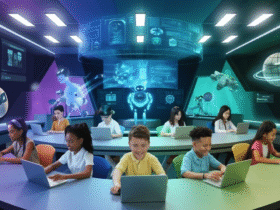Modern education has been completely transformed by the advancements of technological tools that we now have at our disposal.
Blending traditional teaching methods with online aspects has made education more accessible than ever and has proven to be very successful. When surveyed, the majority of students (82%) favor hybrid learning environments for their flexibility.
The online elements and interactive technological aspects are more engaging and appeal to the youth of today. Teaching the heavier course material in an easier-to-digest manner.
Hybrid learning has many benefits and presents a few challenges, which we will discuss in the following guide.
What is Hybrid Learning?
Hybrid learning is basically the combination of traditional in-person teaching with online components. It is sometimes referred to as blended learning because of the mixed nature of the course format and delivery.
It merges online tools and digital platforms for remote learning while utilizing the best components of face-to-face education where necessary. This frees educators up to really focus and double down on instructing classes where attention is truly needed.
It allows students to work at their own pace, giving them autonomy over their course progression, and the online elements are often far more stimulating.
Hybrid learning is dynamic, flexible, and accessible, allowing students to complete parts of the coursework remotely, accommodating different learning preferences and lifestyles. Below are the key components:
Hybrid Learning Components
In hybrid learning, the course structure is split between lecture-style classroom sessions and remote online activities. This could be online assignments, thematic quizzes, and group discussions via online platform tools such as video conferencing.
Students can then engage with the material autonomously and go at their own pace, fitting it around their busy schedules.
How Hybrid Learning Differs From Other Educational Models
Traditional education often means that teachers can’t give as much attention as a student might need.
Online remote learning can be isolating, and students can get overwhelmed or left behind, leading to dropouts.
The combinational style of hybrid learning provides the best of both worlds as a great middle ground.
Hybrid Learning Benefits
The versatility of hybrid learning gives many advantages for both students and educators, catering to a range of learning styles and accommodating difficult schedules. It is also more cost-effective in the long run.
Benefits to Students and Educators
With its flexible elements, students can balance their schedules. Those who might not be able to attend regular full-time education because of work commitments or caring for family members can access resources remotely at a moment that suits them.
It requires less commitment required to get to a physical location.
Teachers can pre-record class content, giving them more one-on-one time with those needing it. The model is beneficial to both, and the results of individuals are often higher 60% of teachers say it improves academic ability.
Better Learning Outcomes
The online aspects free educators up to provide a more personalized approach, and they can tailor their teaching to the individual.
Every learner has their style, the visual learners out there benefit from graphic content, and those who might be a little more timid in the classroom thrive from behind a screen.
With face-to-face discussion and video conferencing, students receive more support than a traditional or fully remote course provides, and this is reflected in test scores and pass rates.
Benefits For Institutions
Hybrid learning has lower operational costs, and with fewer hours in the classroom, institutions don’t have to worry so much about utility bills, building maintenance, and salaries.
With lower costs, course fees can be lowered, providing education to the majority and not just the few.
Hybrid Learning Challenges
Though it has many notable benefits, there are a few challenges that need to be addressed. Of course, technology requires devices, and student engagement can be lower for those who benefit from traditional models.
A balance must be struck between the two elements, and institutions must address student needs.
Technology-related Issues
Hybrid models rely on technology, so students need working devices and a stable connection, which is a potential barrier for some. So, while more accessible than traditional education in some ways, it can still be discriminatory.
Those in remote areas without reliable internet signals might find it an obstacle, as could students from low-income backgrounds.
The model also takes some getting used to for teachers and requires them to be on the tech-savvier side.
The technological aspects also raise security concerns in terms of data protection, so IT cybersecurity infrastructure is important for keeping the online platforms used safe.
Tools such as anti-virus software and encryption are a modern-day necessity for institutions employing hybrid model teaching elements.
Institutions may have to buy VPN services to help secure remote access to their content and educate students on how to use such global online resources safely.
Unsupervised Motivation
The self-guided parts of hybrid learning are a double-edged sword. While many take to it like a duck to water, preferring its versatility, others are less engaged and motivated when they are away from the classroom.
Students who need a teacher supervising them could potentially fall behind, so it is important to get the balance between in-person and remote work just right.
Innovation is required on the teacher’s part and they must keep on top of students’ progress stepping in to motivate when a student loses interest.
Progression Assessment
The online aspects can be harder to track and assess than traditional classwork. Teachers can find it a challenge to gauge progress.
Monitoring becomes more essential in a hybrid model, but with virtual interaction, frequent assessments, and plenty of feedback from both sides, it can be well-managed and successful.
3 Tips for Hybrid Learning Success
With the challenges of hybrid learning, strategies have to be put in place to ensure a successful outcome. Here are some tips for the best learning experience:
#1. Set Achievable Timelines and Goals
As many elements are self-guided, it is crucial to be very clear about expectations. Students need a timeline with goals laid out to help them stay organized.
You can use tools such as digital planners to help them keep track, and teachers also need the same structure for assignments and assessments.
#2. Leverage Modern Resources
Taking advantage of digital resources can greatly enhance the hybrid learning experience. There are many other modern digital resources that can be leveraged in a hybrid learning setup.
Collaborative platforms and video conferencing are two essential tools, but there are a myriad of online resources that can be incorporated to keep learning interactive and engaging for students who are working independently.
#3. Encourage a Dedicated Learning Space
When away from the classroom environment it is important that students have a remote set-up somewhere that is conducive to learning.
Sitting in bed or lounging on the couch with a laptop is often unproductive. Instead, encourage them to dedicate a specific space for their learning to help prevent distractions and keep them on track.
Is Hybrid Learning the Future of Education?
The educational landscape has and still is evolving, modern society is embracing technology and the benefits it presents, and as such it is safe to say that hybrid learning is probably here to stay.
The tools on hand are more sophisticated by the day we are seeing some great personalized learning methodologies emerge at the hands of student data analytics and hybrid frameworks are becoming more and more comprehensive.
The data speaks for itself, the flexibility lowers pressure and students thrive with the mixture of elements with higher average scores.
This customizable approach to education meets far more student needs, and it is definitely the way forward.
By blending the best elements of traditional and online education, hybrid learning presents a powerful educational model.
It is flexible making it far more accessible, especially for those with diverse backgrounds. The content can be personalized with online and AI-assisted tools and the digital elements keep students engaged and make difficult topics fun and easier to get to grips with.
The advantages speak for themselves, but there are also challenges.
With the right strategies, hybrid learning can bridge the gap between in-person and remote learning, providing a dynamic educational experience for everyone.















Leave a Reply